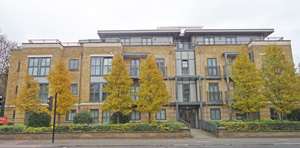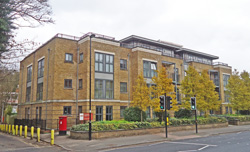Caterham Sanitarium and
Surrey Hills Hydropathic
Surrey Hills Hydropathic
Godstone Road, Caterham, Surrey CR3 6RZ
Medical
dates:
Medical
character:
Chronic
On 5th March 1903 the
Seventh-Day Adventists purchased the former Surrey Hills Hydro and
Turkish Baths for £3,030 from the widow of the hydropathist who
had established it around 1898. Each member of the church was
asked to contribute £1 towards its purchase.
The Caterham Sanitarium and Surrey Hills Hydropathic opened on 30th May 1903 under the management of the Good Health Association Ltd (which also later managed its sister institution, the Watford Sanitarium). An American, Dr Alfred B. Olsen, the son of O.A. Olsen, President of the British Union Conference of the Seventh-Day Adventists, was appointed as Medical Director. A training school for nurses opened in September 1903.
The Sanitarium was conducted on the same lines as Dr J.H. Kellogg's Battle Creek Sanitarium in Michigan, United States (he had coined the term 'Sanitarium', preferring it to 'Sanitorium'). Patients came from all walks of life, including government ministers, clergymen of all Christian denominations, and missionaries. They were given a strictly fruitarian diet - no meat or tea were allowed - and offered a combination of hydrotherapy, electrotherapy, phototherapy and massage treatments. Daily drills were held in physical culture, including Swedish medical-gymnastics. Chronic invalids were accepted for treatment in the belief that the scientific regimen, together with quiet and rest, would be beneficial and even result in a cure. Incurable and offensive patients were not received.
On admission, patients were examined and their course of treatments set out. The hydropathic equipment was in the basement (ladies used it in the first part of the morning, and the gentlemen in the latter part) and included baths of all kinds - tonic, electric light, electric water and Turkish. Other treatments included electric massage, oil rubs, salt glows and packs of every description.
The patients' day began with prayers at a few minutes before 8 o'clock. Breakfast was at 08.15, served communally (as were all meals), with the Medical Superintendent at one end of the table and his wife at the other. After this, patients were free to attend their therapies or lie in a hammock or on the grass in the open air and read, or go for a walk. Lunch was served at 13.45 and dinner at 18.30. A gong was sounded at 21.30 to indicate patients should retire for the night.
Located among the hills of Surrey, with an elevation of 450 feet (135 metres), where the air was clear and bracing, and the water soft and pure, the Sanitarium soon enjoyed a steady patronage. In fact, it proved so successful that, even during WW1, it was extended into other buildings.
After the war, however, the Sanitarium's fortunes began to decline. In 1919 Dr Olsen returned to the United States after his plan for buying more land to extend the institution was rejected. It proved difficult after that to retain the services of a Medical Superintendent for long. Added to this, the road in front was widened and became much busier, making the front rooms difficult to let because of the traffic noise. The situation was exacerbated when a military barracks was established across the road. Its Recreation Hall held dances three times a week, destroying the peace and quiet previously enjoyed. For the first time, the Sanitarium began to run into debt, but the pressure to amalgamate all health work at Stanborough Park finally sealed its fate.
The Sanitarium closed on 31st December 1921.
Present status (December 2013)
The Caterham Sanitarium and Surrey Hills Hydropathic opened on 30th May 1903 under the management of the Good Health Association Ltd (which also later managed its sister institution, the Watford Sanitarium). An American, Dr Alfred B. Olsen, the son of O.A. Olsen, President of the British Union Conference of the Seventh-Day Adventists, was appointed as Medical Director. A training school for nurses opened in September 1903.
The Sanitarium was conducted on the same lines as Dr J.H. Kellogg's Battle Creek Sanitarium in Michigan, United States (he had coined the term 'Sanitarium', preferring it to 'Sanitorium'). Patients came from all walks of life, including government ministers, clergymen of all Christian denominations, and missionaries. They were given a strictly fruitarian diet - no meat or tea were allowed - and offered a combination of hydrotherapy, electrotherapy, phototherapy and massage treatments. Daily drills were held in physical culture, including Swedish medical-gymnastics. Chronic invalids were accepted for treatment in the belief that the scientific regimen, together with quiet and rest, would be beneficial and even result in a cure. Incurable and offensive patients were not received.
On admission, patients were examined and their course of treatments set out. The hydropathic equipment was in the basement (ladies used it in the first part of the morning, and the gentlemen in the latter part) and included baths of all kinds - tonic, electric light, electric water and Turkish. Other treatments included electric massage, oil rubs, salt glows and packs of every description.
The patients' day began with prayers at a few minutes before 8 o'clock. Breakfast was at 08.15, served communally (as were all meals), with the Medical Superintendent at one end of the table and his wife at the other. After this, patients were free to attend their therapies or lie in a hammock or on the grass in the open air and read, or go for a walk. Lunch was served at 13.45 and dinner at 18.30. A gong was sounded at 21.30 to indicate patients should retire for the night.
Located among the hills of Surrey, with an elevation of 450 feet (135 metres), where the air was clear and bracing, and the water soft and pure, the Sanitarium soon enjoyed a steady patronage. In fact, it proved so successful that, even during WW1, it was extended into other buildings.
After the war, however, the Sanitarium's fortunes began to decline. In 1919 Dr Olsen returned to the United States after his plan for buying more land to extend the institution was rejected. It proved difficult after that to retain the services of a Medical Superintendent for long. Added to this, the road in front was widened and became much busier, making the front rooms difficult to let because of the traffic noise. The situation was exacerbated when a military barracks was established across the road. Its Recreation Hall held dances three times a week, destroying the peace and quiet previously enjoyed. For the first time, the Sanitarium began to run into debt, but the pressure to amalgamate all health work at Stanborough Park finally sealed its fate.
The Sanitarium closed on 31st December 1921.
Present status (December 2013)
The building was sold in 1923 for £6,000. Most of the furniture was transferred to the Stanboroughs Hydro and the remainder sold for £1,500. It then became the Hydro Hotel, which was renamed the Surrey Hills Hotel by the 1930s. It was later used for government offices by the Department of Employment for some time, housing the local Job Centre.
It was acquired by the building film Croudace Homes, who had a large Headquarters building opposite, for use as extra offices. Croudace eventually demolished it and, in 2006, built Surrey Hills Court - an apartment block - in its place.

Surrey Hills Court at No. 106, Godstone Road (above and below)

(Author unstated) 1905 At a Surrey Hydro. Good Health 4 (6), 166-169.
Bell M 1992 Health evangelism in the British Isles. Mesenger 90th Anniversary Souvenir Edition 1902-1992. Pp. 19-20.
Griffiths H 2003 The impact of African-Caribbean settlers on the Seventh-day Adventist church in Britain 1952-1992. Thesis, University of Leeds.
Olsen ME 1907 The cure of incurables. Good Health 5 (19), 580-586
Porter D 2007 The Centenary of Stanborough Park. Messenger 112 (22), 1, 8-10.
Porter DS 1974 Chapter 3 The growth of institution and conferences. In: A Century of Adventism in the British Isles. Grantham, Stanborough Press. Pp 9-13.
Ruble WA 1924 The medical work in Great Britain. Missionary Worker. Special Historical Number. Pp. 21-23
www.centerforadventistresearch.org (1)
www.centerforadventistresearch.org (2)
Return to home page